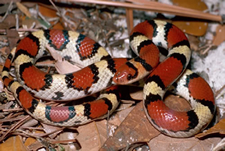The Red Snakes
There are three upstate snakes that are characterized by irregular reddish to orange blotches on their backs. In all cases the red is outlined in black. They are not closely related, live in different habitats, and lead different kinds of lives. And although eye-catching in coloration, most people are unfamiliar with them (due in part to their lack of abundance and secretive life styles). The red snakes include the following three species.
The scarlet snake was once considered a mimic of the venomous coral snake. However, unlike the coral snake, the scarlet snake’s colored bands do not extend onto its belly, and the scarlet snake has a red, not a black, snout. Scarlet snakes grow to 20 inches, are burrowers, and apparently spend much of their time underground.
The milk snake occurs throughout or area, but is most commonly seen in mountain forests. There is uncertainty as to the exact race of milk snake that occurs in upper South Carolina. Some of the mountain specimens are truly beautiful and most resemble the “intergrade” form as shown in the field guide by Conant and Collins. Milk snakes are colorful and close relatives of kingsnakes.
The corn snake in our area it is a largely gray snake with orange/red blotches on its back. A relative of the black rat snake, the corn snake is an adapt climber. They grow to over 4 ft in length and inhabit forest edges.
 |
Scarlet Snake (Cemophora coccinea): red blotches on back, red pointed snout, 2 |
 |
Milk Snake (Lampropeltis triangulum): red blotches on back, rounded snout, 2 |
 |
Corn Snake (Elaphe guttata): orange/red blotches on back, 2 |
